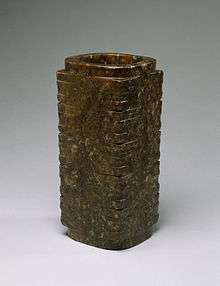Chinese jade
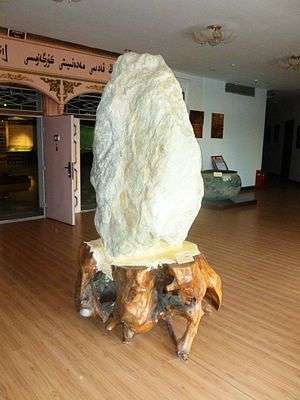


Chinese jade refers to the jade mined or carved in China from the Neolithic onward. It is the primary hardstone of Chinese sculpture. Although deep and bright green jadeite is better known in Europe, for most of China's history, jade has come in a variety of colors and white "mutton-fat" nephrite was the most highly praised and prized. Native sources in Henan and along the Yangtze were exploited since prehistoric times and have largely been exhausted; most Chinese jade today is extracted from the northwestern province of Xinjiang.
Jade was prized for its hardness, durability, musical qualities, and beauty.[1] In particular, its subtle, translucent colors and protective qualities[1] caused it to become associated with Chinese conceptions of the soul and immortality.[2] The most prominent early use was the crafting of the Six Ritual Jades, found since the 3rd-millennium BC Liangzhu culture:[3] the bi, the cong, the huang, the hu, the gui, and the zhang.[4] Although these items are so ancient that their original meaning is uncertain, by the time of the composition of the Rites of Zhou, they were thought to represent the sky, the earth, and the four directions. By the Han dynasty, the royal family and prominent lords were buried entirely ensheathed in jade burial suits sewn in gold thread, on the idea that it would preserve the body and the souls attached to it. Jade was also thought to combat fatigue in the living.[1] The Han also greatly improved prior artistic treatment of jade.[5]
These uses gave way after the Three Kingdoms period to Buddhist practices and new developments in Taoism such as alchemy. Nonetheless, jade remained part of traditional Chinese medicine and an important artistic medium. Although its use never became widespread in Japan, jade became important to the art of Korea and Southeast Asia.
Name

The Chinese word yù 玉 "jade; gems of all kinds; (of women) beautiful; (courteous) your" has semantically broader meanings than English jade "any of various hard greenish gems used in jewelry and artistic carvings, including jadeite and nephrite; a green color of medium hue; made of jade; green like jade".[6][7] Yù has referred to many rocks and minerals that carve and polish well, especially jadeite, nephrite and agalmatolite, as well as bowenite and other varieties of serpentine.[8] Jadeite is now known as yìngyù 硬玉 (lit. "hard jade") and nephrite correspondingly as ruǎnyù 軟玉 (lit. "soft jade"). The polysemous term yù is used in various Chinese chengyu "set phrases, such as pāozhuānyǐnyù 抛砖引玉 (lit. "cast aside a brick, pick up a jade") "offer banal/humble remarks to spark abler talk by others; sacrifice a little to gain much"—one of the Thirty-Six Stratagems, and idioms, for instance yùlì 玉立 (lit. "jade standing") "gracious; graceful".
The Chinese character 玉 for yu "jade" dates back to circa 11th century BCE oracle bone script from the late Shang dynasty, when it depicted pieces of jade hanging on a string. Chinese characters most commonly combine a radical, such as the "jade radical" 玉 or 王, that suggests meaning and a phonetic that hints at pronunciation. The "jade radical" frequently occurs in characters for names of gemstones (e.g., bì 碧 "green jade; bluish green" and shānhú 珊瑚 "coral"), and occasionally for words denoting "preciousness" (bǎo 宝 "treasure" and bǎobǎo 宝宝 "precious/darling baby").
History

Jade has been used in virtually all periods of Chinese history and generally accords with the style of decorative art characteristic of each period. Thus, the earliest jades, of the Neolithic Period, are often quite simple and unornamented ritual and impractical versions of the tools and weapons that were in ordinary use, often much larger than normal examples. These are presumed to have been symbols of political power or possibly religious authority. The bi and cong are types of objects only found in jade in early periods, and probably had religious or cosmic significance. The bi is a circular disk with a hole, originally usually plain, but increasingly decorated, and the cong is a vessel, square on the outside but circular inside. In later literature the cong represents the earth and the bi the sky.
Jades of the Shang, Zhou, and Han dynasties are increasingly embellished with animal and other decorative motifs characteristic of those times, and craftsmen developed great skill in detailed small relief work in objects such as the belt-hooks that became part of elite costume. In later periods ancient jade shapes, shapes derived from bronze sacrificial vessels, and motifs of painting were used, essentially to demonstrate the craftsman's extraordinary technical facility.
During Neolithic times, the key known sources of nephrite jade in China for utilitarian and ceremonial jade items were the now depleted deposits in the Ningshao area in the Yangtze River Delta (Liangzhu culture 3400–2250 BC) and in an area of the Liaoning province in Inner Mongolia (Hongshan culture 4700–2200 BC).[9] As early as 6000 BC, Dushan Jade has been mined. In the Yin Ruins of the Shang Dynasty in Anyang, Dushan Jade ornaments were unearthed in the tombs of the Shang kings.
Jade was used to create many utilitarian and ceremonial objects, ranging from indoor decorative items to jade burial suits, reflecting the ancient Chinese belief that jades would confer immortality or prolong life and prevent decay. From about the earliest Chinese dynasties until the present, jade was sourced from deposits in western regions like Khotan and other parts of China like Lantian, Shaanxi. In Lantian, white and greenish nephrite jade is found in small quarries and as pebbles and boulders in the rivers flowing from the Kun-Lun mountain range northward into the Takla-Makan desert area. River jade collection was concentrated in the Yarkand, the White Jade (Yurungkash) and Black Jade (Karakash) Rivers. From the Kingdom of Khotan, on the southern leg of the Silk Road, yearly tribute payments consisting of the most precious white jade were made to the Chinese Imperial court and there transformed into objets d'art by skilled artisans as jade was considered more valuable than gold or silver, and white more valuable than green. Jade became a favorite material for the crafting of Chinese writing materials, such as rests for calligraphy brushes, as well as the mouthpieces of some opium pipes, due to the belief that breathing through jade would bestow longevity upon smokers who used such a pipe.[10]
Categories
Jade objects of early ages (Neolithic through Zhou) fall into five categories: small decorative and functional ornaments such as beads, pendants, and belt hooks; weapons and related equipment; independent sculptural, especially of real and mythological animals; small objects of probably emblematic value, including the han (ornaments, often carved in the shape of a cicada, to be placed in the mouth of the dead), and many examples of larger objects — such as the cong (a hollow cylinder or truncated cone)
Six Ritual and Six Ceremonial Jades
The Six Ritual Jades originating in pre-history were the bi (a flat disk with a hole in its center), the cong, the huang (a flat, half-ring pendant), the hu, the flat, bladelike gui, and the zhang. The original names, value and functions of these objects have invited much speculation. The Zhou Li, itself probably compiled in the Han Dynasty, ascribes the circular bi as representing the heavens, the cong as representing the earth, the gui the east, the zhang the south, the hu the west and the huang the north. Although over two millennia old these names and symbolism were given to these objects by much later writers, who interpreted the objects in a way that reflected their own understanding of the cosmos.
The original use of the "Six Ritual Jades" became lost, with such jades becoming status symbols, with utility and religious significance forgotten. The objects came to represent the status of the holder due to the expense and authority needed to command the resources and labour in creating the object. Thus it was as the "Ceremonial Jades" that the forms of some of these jades were perpetuated. The "Zhou Li" states that a king (wang) was entitled to gui of the zhen type, dukes (gong) to the huang, marquis to gui of the xin type, earls (bo) to gui of the gong type, viscounts (zi) to a bi of the gu type and barons (nan) to a bi of the pu type.
Gallery of Chinese jades


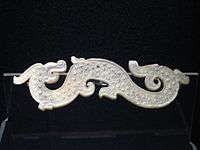
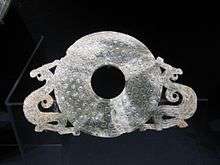

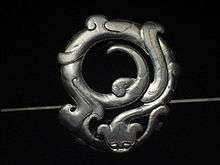
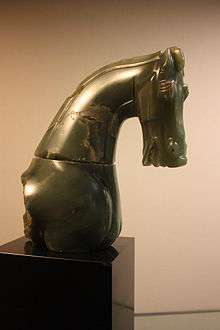 Sculpture of the head and torso of a horse, Han Dynasty
Sculpture of the head and torso of a horse, Han Dynasty
.jpg)
 Cup with dragon handles
Cup with dragon handles
(12th century) hi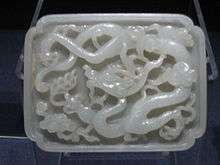


See also
| Wikimedia Commons has media related to Chinese jade. |
References
Citations
- 1 2 3 Fiero, Gloria K. The Humanistic Tradition 6th Ed, Vol. I. McGraw-Hill, 2010.
- ↑ Pope-Henessey, Chapter II.
- ↑ Howard, 19-22
- ↑ Pope-Henessey, Chap. IV.
- ↑ Watson, 77.
- ↑ Wenlin (2016).
- ↑ Collins English Dictionary (2011) jade.
- ↑ Desautels, Paul E. (1986), The Jade Kingdom, Springer, p. 81.
- ↑ Liu, Li 2003:3-15
- ↑ Martin, Steven. The Art of Opium Antiques. Silkworm Books, Chiang Mai, 2007
Bibliography
- Howard, Angela Falco, Chinese sculpture, Yale University Press, 2006, ISBN 0-300-10065-5, ISBN 978-0-300-10065-5. Google books
- Pope-Hennessy, Una, Early Chinese Jades, reprint edn. READ BOOKS, 2008, ISBN 1-4437-7158-9, ISBN 978-1-4437-7158-0 Google books
- Scott-Clark, Cathy and Levy, Adrian. (2002) The Stone of Heaven: Unearthing the Secret History of Imperial Green Jade. ISBN 0-316-52596-0
- Watson, William, & Ho, Chuimei. The arts of China after 1620, Yale University Press Pelican history of art, Yale University Press, 2007, ISBN 0-300-10735-8, ISBN 978-0-300-10735-7
Further reading
- Laufer, Berthold, 1912, Jade: A Study in Chinese Archeology & Religion, Reprint: Dover Publications, New York. 1974.
- Rawson, Jessica, 1975, Chinese Jade Throughout the Ages, London: Albert Saifer, ISBN 0-87556-754-1
- Art in Quest of Heaven and Truth: Chinese Jades through the Ages. Taipei: National Palace Museum.
- Between hell and the Stone of Heaven: Observer article on Jade Mining in Burma
- Old Chinese Jades: Real or Fake?
- BOOK REVIEW, The Stone of Heaven: The Secret History of Imperial Green Jade by Adrian Levy and Cathy Scott-Clark
